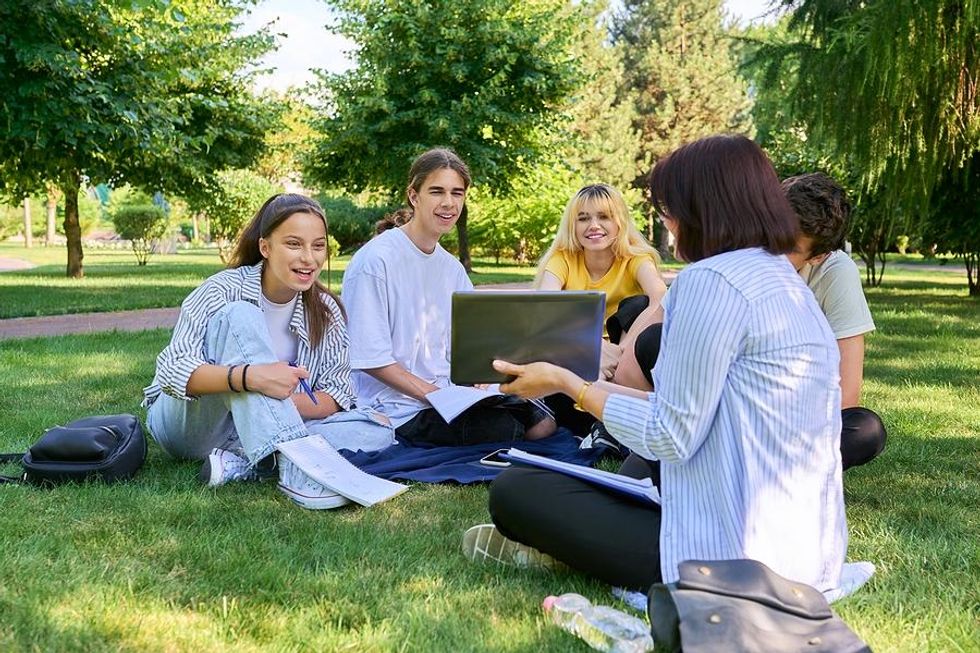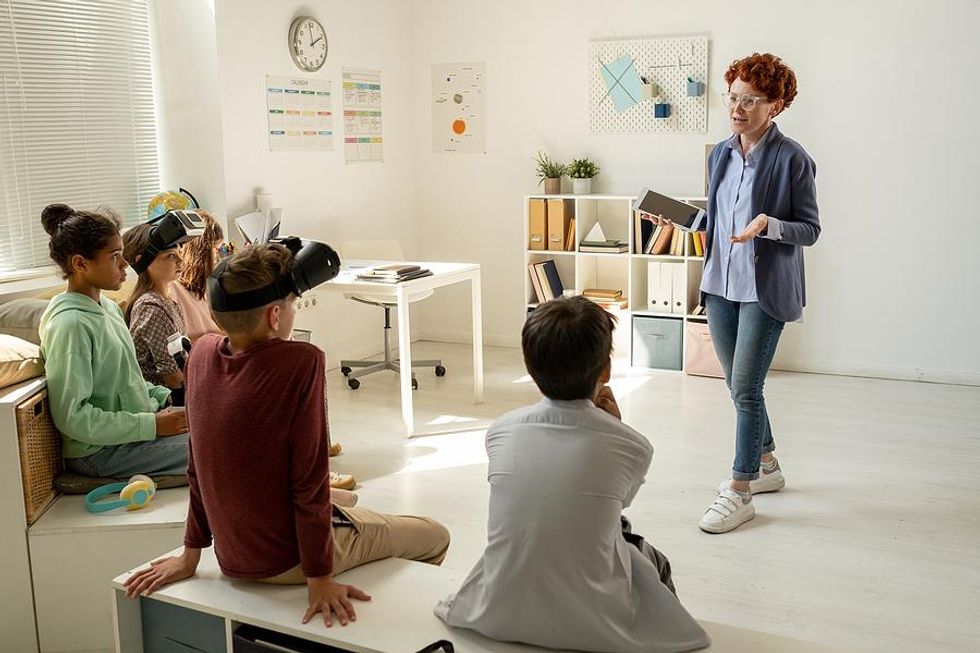
I must admit. I don’t enjoy being off in the summer as an educator. I enjoy a beach day from time to time, like most people, but I can tolerate sweeping up sand in my house only so much. So, you might understand, when I was still teaching in the classroom, why I jumped at the chance to teach English as a foreign language during the summer program of an American school outside of London. The international students and teachers were a fun and diverse lot, and, on days when I wasn’t responsible for afterschool activities and/or in charge of my dormitory, I still had time to rush to the train into London to catch a late-in-day visit to a museum or to swing dance in an old hotel basement ballroom somewhere near Marble Arch.
This was a fun time in my life. And, while I recognize that many educators can’t just jet off to Paris, Rome, or Timbuktu over their summer break, there are still many ways through which we can both rest and recharge as well as prepare for the upcoming school year.
Here are some suggestions for how educators might make the most of their summer holiday:
Rest

Bigstock
Yes, recharge. Go to the beach with that book you’ve been itching to read but have had no time to do. NPR recently released a list of books about each of the 50 states while The New York Times also published a list of great summer reads. I, myself, have always been a fan of librarian Nancy Pearl’s book recommendations. Remember, though, the early bird catches the worm so don’t let the summer pass you by without engaging in at least some of the following activities which will pay you dividends throughout the entirety of the next school year.
Teach

Bigstock
You heard me correctly. Teach. While it might be late in the game to acquire a summer teaching position for this summer, consider looking for summer work in the late winter/early spring prior to the summer in which you want to teach. I knew that I wanted to both teach and visit the UK, so I took advantage of low winter airfares and flew to the UK for a few days, in February, to conduct interviews with various English language schools; this is how I ultimately ended up teaching at the American school that summer. Again, one need not fly across the globe to acquire work as summer teaching jobs may be available right around the corner within your own or the next school district.
Why be a glutton for punishment? Teaching over the summer can be a great way to experience another school and/or school district without committing full time. At the same time, one’s cash flow continues. Should you teach over the summer, you also may have an opportunity to extend your professional network which will be important if/when you decide to look for new teaching opportunities.
Prepare Incoming Students

Bigstock
The summer learning slide is real. A Scholastic survey finds that children in 3rd to 5th grades lose, on average, about 20 percent of their school-year gains in reading and 27 percent of their school-year gains in math during summer break. If you know who your students will be for the coming year, consider providing them with some summer work to keep their minds agile. Many public libraries, such as the New York Public Library, also publish summer reading educator guides. Consider assigning some of these books to students.
Get To Know Incoming Students

Bigstock
There is a difference between preparing students for learning and knowing who students are as individuals, both personally and academically. Consider conducting interest and strength surveys with incoming students. Also, find out how students like to be recognized be that through praise/prestige, prizes, power, people, and/or play (The Five P’s). This can help to incentivize learning for students. Strength assessments also can assist teachers in grouping students during project-based learning.
You also can get to know students academically early on by conducting benchmark skills assessments—such as NWEA Map Growth—in the late summer or early autumn and then by measuring student academic progress in the late winter and, again, in the early spring. This way, teachers both know the skills that need to be taught and have the time to teach them rather than cramming for state tests at the end of each academic year. Take the time now to pre-assess student academic skills so you will know what parts of the curriculum scope and sequence to focus on this coming year. Base your decisions on identified student needs as indicated by these benchmark assessments. If your school does not use a formal diagnostic tool, create your own benchmark assessment and/or use previously administered state exams.
Share Knowledge Of Outgoing Students

Bigstock
Consider connecting with teachers who will have your outgoing students next year to share important information about these students. Many schools often systematize/schedule these teacher meetings formally for the late spring or when teachers return for pre-service days in late summer. I also have worked with schools that maintain student work portfolios that follow students from grade to grade which is a wonderful way to measure student progress on academic standards—even better if students can discuss their progress with teachers and parents by referencing these portfolios.
Take A Class Or Go On A Study Tour

Bigstock
Within my own subject area of social studies, organizations such as Facing History and the Gilder Lehrman Institute of American History often offer teacher seminars over the summer which not only help teachers build up their professional learning hours but can help educators increase the quality of resources/materials used within their classrooms.
Many organizations also offer grants and stipends to teachers so that they can participate on study tours over the summer. As for myself, I will be forever indebted to the NJ Holocaust Commission and Federation of Metro West which financially supported my European study tour, and NJPSA for supporting my study of the post-Apartheid education system in South Africa. I networked with wonderful teachers interested in similar topics, learned something about new places, and further developed my own teaching practice by participating on these journeys. Don’t assume that trips like this are automatically out of your reach as you could be losing out on amazing opportunities. It's about being proactive in one’s research as to which teacher-facing organizations offer such programs in specific content areas and which provide funding.
Line Up Expert Speakers

Bigstock
Last week, I observed two middle school teachers deliver a lesson on drought and global warming. This got me thinking about the many experts dedicating their lives to this problem and prompted me to ask these teachers if they ever considered having a guest speaker on the topic. The teachers’ response was that there was no time to schedule this enrichment activity. During the year, this reluctance is understandable given the long list of tasks that teachers have. Sadly though, this is such a lost opportunity for real-world relevance in learning.
Over the summer, take your curriculum scope and sequence and plan out the scheduling of potential speakers. Many experts in their field of study would not only be excited to meet with your students (in person or virtually) but such relationships often result in increased student engagement through inquiry, more formalized community partnerships, and additional work-study opportunities for older students.
Makeover The Classroom

Bigstock
I once worked with a teacher who had two large desks in the classroom, taking up one-third of total class space, and who also had the classroom walls plastered over with New York Jets paraphernalia. Sure. We want students to know teachers as people, but how large is your footprint in the classroom versus that of the student? Consider how you might increase student ownership of the classroom by arranging furniture collaboratively, having areas for individual study and/or technology-infused learning, removing unused textbooks, papers, and posters, and designating wall space for specific student academic supports (anchor charts) and student-generated work that will be completed during the upcoming school year. Further, curate and update classroom libraries (MUSTIE).
If you would like additional ideas on how to impact student lives without sacrificing your own, and have a life teaching, check out my quick hack teaching courses here. You can also reach me on LinkedIn.
- 7 Best Summer Jobs For Teachers - Work It Daily ›
- 6 Things To Know Before Becoming A Teacher - Work It Daily ›
- 4 Strategies Educators Are Using To Revolutionize Teaching - Work ... ›
- 11 Ways To Enjoy Summer When You're Working A Full-Time Job ... ›
- How To Address Teacher Shortages In The U.S (And Beyond) - Work It Daily ›
- 8 Tips For Increasing Student Engagement In The Classroom - Work It Daily ›
- How And Why All Teachers Must Teach Vocabulary - Work It Daily ›
- 5 Fun Summer Work Activities For Bonding With Your Coworkers - Work It Daily ›

 Bigstock
Bigstock Bigstock
Bigstock Bigstock
Bigstock


